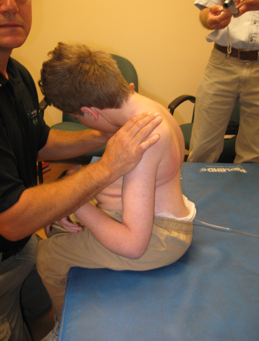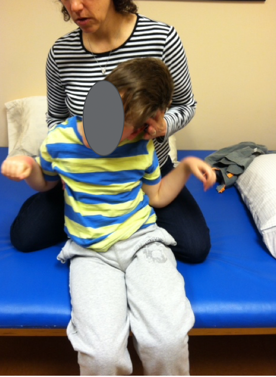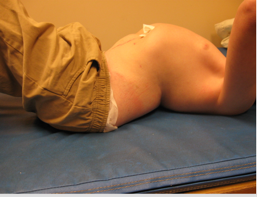What We Will Be Covering
- What is a “prop sitter”?
- Clinical Guidelines
- Case Study
Today, we are going to be talking about wheelchair seating and considerations for the prop sitter (Figure 1).

Figure 1. Example of a prop sitter.
First, what is a prop sitter? How does that relate to other types of wheelchair sitters? What are some clinical guidelines when working with this person and determining the most appropriate wheelchair seating? Finally, we will wrap up with a case study to put a face on this category of wheelchair sitter and the solutions we used.
SMS Series
- This is part of a series of webinars designed to prepare the participant for the Seating and Mobility Specialist examination
- And… develop more advanced seating and wheeled mobility skills
This is part of a series of webinars that are primarily designed to help someone who already works in this specialty area of wheelchair seating and mobility to prepare for an examination called the Seating Mobility Specialist exam. This is a certification that is available through RESNA. If this is something that you are interested in pursuing, you should check out this series of webinars. In fact, the first webinar addresses the SMS examination and certification process, what the prerequisites are, et cetera. I hope that this series of webinars will help you to prepare for that and successfully pass and receive this designation. But whether or not you are looking at getting the SMS certification, I hope that this series of webinars will help you develop more advanced seating and wheeled mobility skills so that you can better address the needs of the clients with whom you work.
Seating and Wheeled Mobility
- Every mobility base includes some form of seating
- Primary supports include a seat, back, armrests, and footrests
- Seating interventions vary tremendously depending on the client's age, diagnosis, prognosis, postural needs, pressure risks, etc.
Every mobility base, whether it is an adaptive stroller, a manual chair, or a power chair includes some form of seating, and this is primarily where the client bears weight. These are called the primary support surfaces and include the seat, the back, the armrest, and the footrest and footplates. From there, the specific seating interventions are going to vary quite a bit and depend on the individual client, their age, their diagnosis, prognosis, postural needs, their risk of pressure injury, et cetera.
Postural Needs
- One way of looking at wheelchair seating is by postural support needs:
- Hands-free sitter
- Hands-dependent sitter
- Prop sitter
One way of looking at wheelchair seating is by categorizing the clients that we are working with by the amount of postural support that they require. These categories are referred to as the hands-free sitter, the hands-dependent sitter, and the prop sitter. There are courses available to you on the hands-free sitter and the hands-dependent sitter, and along that continuum, we now address the prop sitter. Let's talk about what each of these terms may mean.
The Hands-free Sitter
- The person is able to lift their hands off of the surface without changing the position of the trunk
- Can also shift weight to the side and return to a midline position
- Good trunk control
As a quick review, a hands-free sitter is a person who is able to lift their hands off of the seating surface without changing the position of their trunk. They are not going to fall over or collapse in their trunk, and they are able to maintain that position. This person can shift their weight to the side a little bit and return to the midline. This person has good trunk control.
The Hands-dependent Sitter
- This person uses one or both hands on a surface to maintain sitting balance
- If hands are lifted, the trunk will collapse
The hands-dependent sitter needs to use one or both hands on the surface to maintain their sitting balance. Otherwise, if they lift a hand or both hands, either the client will fall over or the trunk will collapse into a posterior flexed kyphotic posture or might collapse to the side.
The Prop Sitter
- This person cannot maintain sitting, even with the support of both arms
- External support is required
The prop sitter, who we are talking about today, cannot maintain sitting even with the support of both their arms, as shown in Figure 2. And, some clients cannot get their arms down towards the seating surface. However, even if they could, they need a lot more postural support.

Figure 2. Another example of a prop sitter.
For these types of cases, we need to bring in external support.
The Prop Sitter
Goals
- Provide adequate proximal support for improved function
- Optimize function
- The function may be more basic, such as improved breathing and swallowing, rather than increased participation in MRADLs (mobility-related ADLs)
- Prevent the development of or accommodate asymmetrical postures
- Mitigate pressure issues
What are our goals when we are working with this prop sitter, or someone who needs more significant postural support? We want to provide adequate support proximally, close to the body, to help this person to be as functional as possible. Now, for the prop sitter, this function may be more basic. This person may have enough physical involvement that even with adequate wheelchair seating, this client may not be able to participate in their MRADL. That is a nice Medicare term for mobility-related ADLs. So, when I am working with someone who is in this category, even if I recommend an optimal seating system for them, it does not mean that they now can cook dinner for the family. However, there still can be a functional change. The client may now be able to use their assistive technology, like a communication device or their power wheelchair. It can also be even more basic than that. With the appropriate positioning devices, they may have improved breathing and swallowing. These are very key medical changes that need to be on our radar and certainly can justify the recommendations we are making.
We also want to prevent the development of or accommodate already existing asymmetrical postures. If this person has a tendency towards lateral scoliosis of the spine, we want to provide adequate support of the trunk to minimize the risk of that development. Or, if there is already an asymmetry of the spine, we want to appropriately accommodate that. We want to mitigate any pressure risk for this client as well.
Many prop sitters tend to fall into one of two subcategories; clients that have little or no postural asymmetries or clients that have significant non-reducible asymmetries. Let's start with the first. Some clients need a lot of support from their seating system but do not yet have postural asymmetries. If they fall into an asymmetric position, we can correct it. Everything is reducible or flexible. These clients often have low tone in their trunk. This may be a new diagnosis, an acquired injury, or a younger child, where we are not having to deal with accommodation yet. In these cases, we are looking at providing adequate postural support and prevention. Then, there are the clients who have significant non-reducible asymmetries, as this young man from the earlier picture as shown lying on the mat table (Figure 3).

Figure 3. Example of a fixed deformity.
